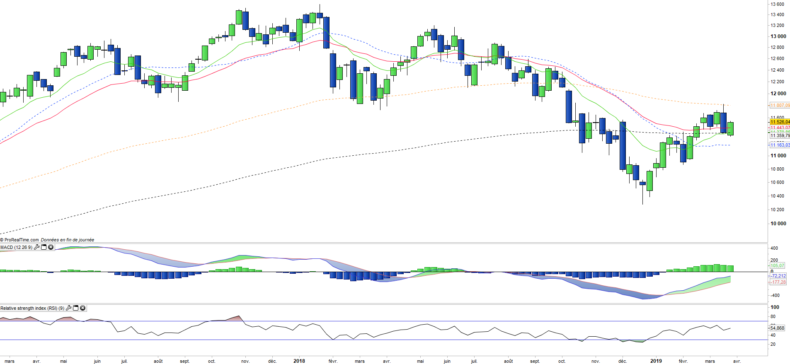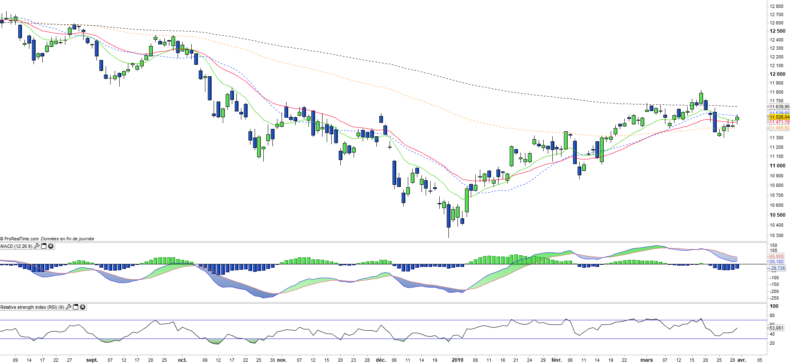DAX index - DAX - 31/03/19
Short Term trend: Negative (40%)
Long Term trend: Negative (35%)
(scores computed by our proprietary algorithms - cf methodolgy)
pour accéder à nos achats / ventes sur les indices
Index profile
The top 10 stocks are mainly large industrial stocks such as Siemens or Bayer, while there are only 2 financial stocks in the DAX: Allianz and Munchener Rueck, the German master index is relatively small and mostly composed of large industrial groups.
Unlike the English, French or Italian indices, the DAX is also distinguished by the absence of large oil companies that weigh heavily in the weighting of the CAC40, FTSE100 or FTSEMIB40, which is double-edged according to the cycle specific to energy sector.
In addition, the financials weigh only 16% of the index, half for the insurance giant Allianz, so the banking sector has a low weight reflected in the well-known weakness of Deutsche Bank and Commerzbank. Conversely, the automotive and chemical sectors are heavier than the other European indices, while the technology sector is mainly represented by SAP (10%) whose market capitalization exceeds € 100 billion.
In summary, the DAX is a fairly strong index from a sectoral point of view which can make it evolve differently from other European indices. German fundamentals are very solid (historically low unemployment rate at 5.5% and accelerated deleveraging up to 2020).
The main risks concern Germany's main customers, namely the United Kingdom, which could suffer from Brexit, the US in political uncertainty and threatening it with a trade war, Russia which remains a difficult and aggressive neighbor and China because of its commercial practices which also tend to limit access to its domestic market to Western industrialists, particularly in the automotive and technology sectors.
After an increase of 6.9% in 2016, the DAX30 grew by 12.5% in 2017, more than the stoxx600 (+ 10.6%). But the index fell by 18.5% in 2018, which is a much lower performance than the Stoxx600NR (-10.7%). The DAX starts a rebound since the beginning of the year (+ 9.2%) which seems very fragile in comparison with other european indexes. This poor performance reflects the large share of cyclical stocks (chemicals, autos, equipment goods) in the index and the exposure to international trade endangered by the US protectionist attitude and fears over the Chinese growth on which German companies are increasingly dependent.
The weakening of the Chinese economy and in particular the automotive sector is a matter of concern for the German industry, which is almost in recession.
Instruments: DBXD (DB-x Tracker in Euro), DAXEX (iShares in Euro), DAX (Lyxor in Euro)
Technical analysis
Weekly analysis
On the weekly chart, we can see that the index remains in a rather negative and uncertain trend in the short and medium term. Prices remain locked under EMA100 and EMAS13 and 26 have not crossed yet. The underperformance of the DAX relative to the other European indexes remains significant and a relapse cannot be ruled out. In particular, the overshoot of the EMA100, which would give a positive reversal signal, will be monitored.
Daily analysis
The daily chart allows to visualize a blocking situation of prices that fail to pass over the EMA200 despite several attempts during the month of March. The index seems to prepare a new attack of the resistance become the major one short term, with a return of prices above the EMAs13 and 26. The EMA200 remains more than ever the pivot level to monitor, whose overtaking is necessary to validate a possible reversal of the short-term trend.
Country beakdown
| Germany | 100% |
Sector breakdown
| Materials | 18% |
| Consumer discretionary | 16% |
| Financials | 16% |
| Information technology | 14% |
| Industrials | 12% |
| Health Care | 11% |
| Comunication services | 5% |
| Others | 9% |
Top Ten holdings
| SAP | 10% |
| Allianz | 9% |
| Linde | 9% |
| Siemens | 8% |
| BASF | 6% |
| Bayer | 6% |
| Daimler | 5% |
| Deutsche Telekom | 5% |
| Adidas | 4% |
| Muenchener Rueckver | 3% |


